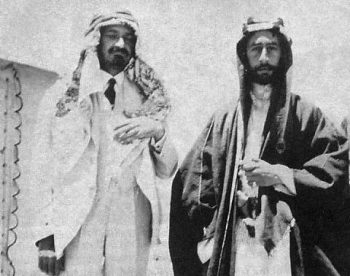In London, on 3 January 1919, Chaim Weizmann, leader of the Zionist movement, and King Feisal of Hegiaz, a loyal ally of the British during World War I, signed an agreement on the policy to be implemented in the ex-Ottoman Palestine from a few months Under British control: in the next picture they are portrayed together in their first meeting in Aqaba in 1918 (Weizmann is on the left of those who read).
This time, the meeting takes place at the Carlton Hotel in London and was wanted and organized by Colonel Thomas Edward Lawrence, better known as Lawrence of Arabia, the extraordinary protagonist from the Arab guerrilla warfare against the Turks, who led him to To share intimately the aspirations of independence of the Arab people: feelings and experiences that will pour into his beautiful book The Seven Pillars of Wisdom.
The agreement of 3 January 1919 will actually be overwhelmed by the facts within a few months. It weighs in fact on it the unscrupulous British imperial conduct, which played on several tables at the same time: At first splitting the remains of the Arab Middle East with the French (agreement Sykes-Picot, 1916), then activating the influential support of the International Zionist Movement (Balfour Declaration, 1917), fundamental to obtaining American intervention in the conflict, finally maneuvering the Arabs, precisely through the action of the Arab Bureau in which the promising lieutenant had been recruited Lawrence.
The figures of the population of Palestine at December 31, 1918 speak clearly: There are 618,000 Muslims, 70000 Christians, 7000 Druze and 59000 Jews.
Weizmann's position is cleverly ambiguous: by repeatedly denying Allied leaders to have any aspiration to create a genuine Jewish state in Palestine, it makes the Hashemite ruler Flash the prospect of a substantial contribution of capital Jewish and technical-scientific know-how, both of which the Zionists have, to develop Palestine as a privileged point of contact with the West. The Arab King hopes that such a collaboration with the Zionists will be able to bridge the technical-economic gap with Westerners, as shown by art. 4 of the Agreement:
All the necessary measures will be taken to encourage and stimulate large-scale immigration of Jews to Palestine and to establish Jewish immigrants in the territory as quickly as possible, through closer settlements and through the cultivation Intensive soil. In adopting these measures, Arab peasants and renters must be protected in their rights and must be assisted in increasing their economic development 1.
But for the British the prospect of an Arab-Zionist integration in the Middle East is looked at with great concern, as he explained with clear argument Lord Curzon, at the time president of the British Government Commission for the Middle East ( Eastern Committee):
I strongly abhor the idea of Feisal being pushed by the Zionists, which I believe would be fatal. What would result? With the Zionists already in an influential position in Palestine and who finance, administer, arm and control Syria, it would become one of the most formidable forces in the Middle East. It would be a "New Jerusalem" to the fullest degree 2.
Thus, since before the negotiations of the Congress of Versailles began, the Bloody conflictual destiny of contemporary Palestine is clearly traced, between ambiguities, double games and colonialist politics.
Lawrence's dream will dissolve immediately, bringing the same selfless leader of the Arab Revolt to abandon any collaboration with his British Majesty's Government, to conclude the parable of his adventurous and romantic existence in an accident Motorcycle of which still remains unexplained the dynamic.
- English text in: http://www.mideastweb.org/feisweiz.htm Italian translation by of the editor↩
- knightly P., Simpson C., the secret Lives of Lawrence of Arabia, London, 1969, P. 130↩


